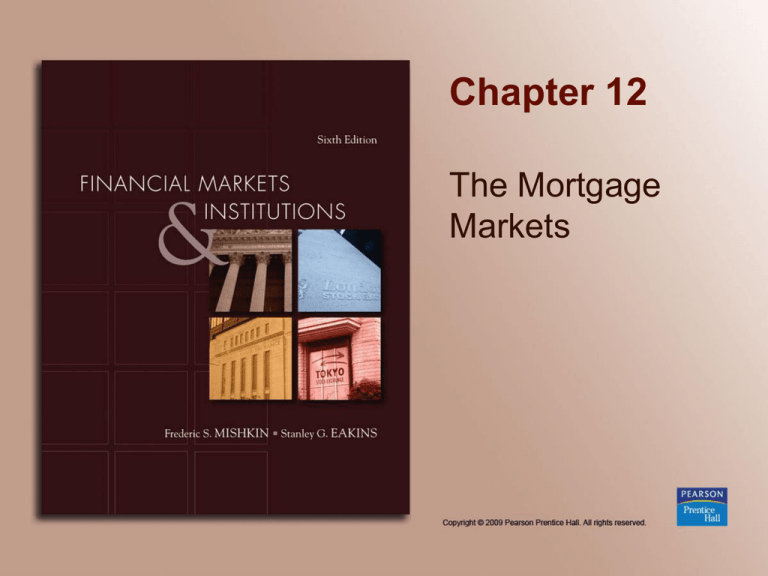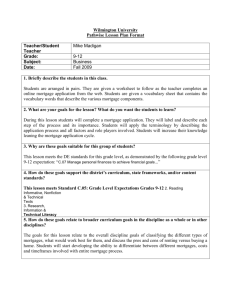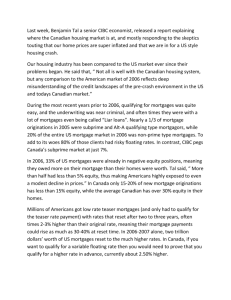
Chapter 12
The Mortgage
Markets
Chapter Preview
Part of the American Dream is to own your
own home. But the average price of a
home is well over $140,000 (and quite a bit
higher is some areas, like California). For
most of us, home ownership would be
impossible without borrowing most of the
cost of a home.
Copyright © 2009 Pearson Prentice Hall. All rights reserved.
12-2
Chapter Preview
• In this chapter, we identify characteristics of
typical residential mortgages and the usual term
and types of mortgages available. We then
review who provides and services the loans,
along with the growth in the secondary mortgage
market. Topics include:
– What Are Mortgages?
– Characteristics of Residential Mortgages
– Types of Mortgage Loans
– Mortgage-Lending Institutions
Copyright © 2009 Pearson Prentice Hall. All rights reserved.
12-3
Chapter Preview (cont.)
– Loan Servicing
– Secondary Mortgage Market
– Securitization of Mortgages
– The Impact of Securitized Mortgages on the
Mortgage Market
Copyright © 2009 Pearson Prentice Hall. All rights reserved.
12-4
What Are Mortgages?
• A long-term loan secured by real estate
• An amortized loan whereby a fixed
payment pays both principal and interest
each month
Copyright © 2009 Pearson Prentice Hall. All rights reserved.
12-5
What Are Mortgages?
• The next slide shows the total amount of
mortgage debt outstanding in the U.S.
during 2006. It further delineates by type
of property.
• The table shows roughly $13 trillion
outstanding. How does this compare to the
value of all the stock on the NYSE?
Copyright © 2009 Pearson Prentice Hall. All rights reserved.
12-6
What Are Mortgages?
Mortgage Loan Borrowers
Copyright © 2009 Pearson Prentice Hall. All rights reserved.
12-7
What Are Mortgages? History
• Mortgages were used in the 1880s, but
massive defaults in the agricultural
recession of 1890 made long-term
mortgages difficult to attain.
• Until post-WWII, most mortgage loans were
short-term balloon loans with maturities of
five years or less.
Copyright © 2009 Pearson Prentice Hall. All rights reserved.
12-8
What Are Mortgages? History
• Balloon loans, however, caused problems
during the depression. Typically, the lender
renews the loan. But, with so many
Americans out of work, lenders could not
continue to extend credit.
• As a part of the depression recovery
program, the federal government assisted
in creating the standard 30-year mortgage
we know today.
Copyright © 2009 Pearson Prentice Hall. All rights reserved.
12-9
Characteristics of
the Residential Mortgage
• Mortgages can be roughly classified along
the following three dimensions:
– Mortgage Interest Rates
– Loan Terms
– Mortgage Loan Amortization
Copyright © 2009 Pearson Prentice Hall. All rights reserved.
12-10
Characteristics of the Residential
Mortgage: Mortgage Interest Rates
• The stated rate on a mortgage loan is
determined by three rates:
– Market Rates: general rates on
Treasury bonds
– Term: longer-term mortgages have
higher rates
– Discount Points: a lower rates negotiated for
cash upfront
Copyright © 2009 Pearson Prentice Hall. All rights reserved.
A variety of fun mortgage calculators
http://interest.com/calculators/index.shtml
12-11
Characteristics of the Residential
Mortgage: Mortgage Interest Rates
• The next slide shows the relationship
between mortgage rates and long-term
treasury rates. As can be seen, mortgage
rates are typically higher than Treasury
rates, but the spread (difference) between
the two varies considerably.
Copyright © 2009 Pearson Prentice Hall. All rights reserved.
A variety of fun mortgage calculators
http://interest.com/calculators/index.shtml
12-12
Characteristics of the Residential
Mortgage: Mortgage Interest Rates
Copyright © 2009 Pearson Prentice Hall. All rights reserved.
Current mortgage interest rates
http://www.interest.com/
12-13
Characteristics of the Residential Mortgage:
Mortgage Interest Rates & Points
• A difficult decision when getting a mortgage is
whether to pay points (cash) upfront in exchange
for a lower interest rate on the mortgage.
Suppose you had to choose between a 12% 30year mortgage or an 11.5% mortgage with 2
discount points. Which should you choose?
Assume you wished to borrow $100,000.
Copyright © 2009 Pearson Prentice Hall. All rights reserved.
A variety of fun mortgage calculators
http://interest.com/calculators/index.shtml
12-14
Characteristics of the Residential Mortgage:
Mortgage Interest Rates & Points
First, examine the 12% mortgage.
Using a financial calculator, the required
payments is:
n = 360, i = 1.0, PV = 100,000,
Calculate the PMT. PMT = $1,028.61
Copyright © 2009 Pearson Prentice Hall. All rights reserved.
12-15
Characteristics of the Residential Mortgage:
Mortgage Interest Rates & Points
Now, examine the 11.5% mortgage. Using
a financial calculator, the required
payments is:
n = 360, i = 11.5/12, PV = 100,000,
Calculate the PMT. PMT = $990.29
Copyright © 2009 Pearson Prentice Hall. All rights reserved.
12-16
Characteristics of the Residential Mortgage:
Mortgage Interest Rates & Points
• So, paying the points will save you $38.32
each month. However, you have to pay
$2,000 upfront.
• You can see that the decision depends on how
long you want to live in the house, keeping the
same mortgage.
Copyright © 2009 Pearson Prentice Hall. All rights reserved.
12-17
Characteristics of the Residential Mortgage:
Mortgage Interest Rates & Points
• If you only want to live there 12 months,
clearly the $2,000 upfront cost is not worth
the monthly savings.
• Let’s see how to determine the answer.
Copyright © 2009 Pearson Prentice Hall. All rights reserved.
12-18
Characteristics of the Residential Mortgage:
Mortgage Interest Rates & Points
You need to determine when the present
value of the savings ($38.32) equals the
$2,000 upfront. Using a financial
calculator, this is:
i = 1, PV = -2,000, PMT = 38.32
Calculate n. n = 74 months, or about
6.2 years.
Copyright © 2009 Pearson Prentice Hall. All rights reserved.
12-19
Characteristics of the Residential Mortgage:
Mortgage Interest Rates & Points
So, if you think you will stay in the house
and not refinance for at least 6.2 years,
paying the $2,000 for the lower payment is
a sound financial decision.
Otherwise, you should accept the
12% loan.
Copyright © 2009 Pearson Prentice Hall. All rights reserved.
12-20
Characteristics of the Residential Mortgage:
Mortgage Interest Rates & Points
The next table further illustrates this point,
showing the effective rate on the 11.5%
mortgage if the mortgage is paid in full at
various points.
Note that right around year 6, the effective
annual rate on the 11.5% mortgage is
about the same as effective annual rate on
the 12% mortgage (12.68%).
Copyright © 2009 Pearson Prentice Hall. All rights reserved.
12-21
Characteristics of the Residential
Mortgage: Effective Rate of Interest
Copyright © 2009 Pearson Prentice Hall. All rights reserved.
12-22
Characteristics of the Residential
Mortgage: Loan Terms
Mortgage loan contracts contain many legal
terms that need to be understood. Most
protect the lender from financial loss.
• Collateral: usually the real estate
being finance
• Down payment: a portion of the purchase
price paid by the borrower
Copyright © 2009 Pearson Prentice Hall. All rights reserved.
12-23
Characteristics of the Residential
Mortgage: Loan Terms
Mortgage loan contracts contain many legal
terms that need to be understood. Most
protect the lender from financial loss.
• PMI: insurance against default by
the borrower
• Qualifications: includes credit history,
employment history, etc., to determine the
borrowers ability to repay the mortgage as
specified in the contact
Copyright © 2009 Pearson Prentice Hall. All rights reserved.
12-24
Characteristics of the Residential
Mortgage: Loan Terms
Lenders will also order a credit report from
one of the credit reporting agencies.
• The score reported is called the FICO.
• The range is 300 to 850, with 660 to 720
being average.
• Payment history, debt, and even credit card
applications can affect your credit score.
Copyright © 2009 Pearson Prentice Hall. All rights reserved.
12-25
Characteristics of the Residential
Mortgage: Loan Amortization
Mortgage loans are amortized loans. This
means that a fixed, level payment will pay
interest due plus a portion of the principal
each month. It is designed so that the
balance on the mortgage will be zero when
the last payment is made.
The next table shows a typical amortization
table for a 30-year mortgage at 8.5%.
Copyright © 2009 Pearson Prentice Hall. All rights reserved.
12-26
Characteristics of the Residential Mortgage:
Loan Amortization Schedule
Copyright © 2009 Pearson Prentice Hall. All rights reserved.
12-27
Types of Mortgage Loans
• Insured vs. Conventional Mortgages: if the
down payment is less than 20%, insurance
is usually required
• Fixed-Rate Mortgages: the interest rate is
fixed for the life of the mortgage
• Adjustable-Rate Mortgages: the interest
rate can fluctuate within certain parameters
Copyright © 2009 Pearson Prentice Hall. All rights reserved.
12-28
Types of Mortgage Loans
• Other Types
–
–
–
–
–
–
Graduated-Payment Mortgages (GPMs)
Growing Equity Mortgages (GEMs)
Shared-Appreciation Mortgages (SAMs)
Equity Participation Mortgages
Second Mortgages
Reverse Annuity Mortgages (RAMs)
• The following table lists additional
characteristics on all the loans.
Copyright © 2009 Pearson Prentice Hall. All rights reserved.
12-29
Types of Mortgage Loans
Copyright © 2009 Pearson Prentice Hall. All rights reserved.
12-30
Mortgage-Lending Institutions
• Originally, thrift institutions were the primary
originator of mortgages in the U.S. and,
therefore, the primary holder of mortgage
loans.
• As the next figure illustrates, this is not the
case anymore.
Copyright © 2009 Pearson Prentice Hall. All rights reserved.
12-31
Mortgage-Lending Institutions
Copyright © 2009 Pearson Prentice Hall. All rights reserved.
12-32
Loan Servicing
• Most mortgages are immediately sold to
another investor by the originator. This
frees cash to originate another loan and
generate additional fee income.
• Still, someone has to collect the monthly
payments and keep records. This is knows
as loan servicing, and servicers usually
keep a portion of the payments received to
cover their costs.
Copyright © 2009 Pearson Prentice Hall. All rights reserved.
12-33
Loan Servicing
In all, there are three distinct elements in
mortgage loans:
• The originator packages the loan for
an investor
• The investor holds the loan
• The servicing agent handles the paperwork
Copyright © 2009 Pearson Prentice Hall. All rights reserved.
12-34
Secondary Mortgage Market
• The secondary mortgage market was
originally established by the federal
government after WWII when it created
Fannie Mae to buy mortgages from thrifts.
• The market experienced tremendous
growth in the early to mid-1980, and has
continued to remain a strong market in
the U.S.
Copyright © 2009 Pearson Prentice Hall. All rights reserved.
12-35
Securitization of Mortgages
The securitization of mortgages developed
because of problems dealing with single
mortgages: risk of either default or
prepayment and servicing. Pools of
mortgages eliminated part of this problem
through diversification.
Copyright © 2009 Pearson Prentice Hall. All rights reserved.
12-36
Securitization of Mortgages
The mortgage-backed security (MBS) was
created. Pools including hundreds of
mortgages were gathered, and the rights to
the cash flows generated by the mortgages
were sold as separate securities.
At first, simple pass-through securities
were designed.
Copyright © 2009 Pearson Prentice Hall. All rights reserved.
12-37
Securitization of Mortgages:
The Mortgage Pass-Through
• Definition: A security that has the
borrower’s mortgage payments pass
through the trustee before being disbursed
to the investors
• This design did eliminate some risk, but
investors still faced prepayment risk.
Copyright © 2009 Pearson Prentice Hall. All rights reserved.
12-38
Securitization of Mortgages: CMOs
• Definition: A CMO is a structured MBS
where investor pools have different rights to
different sets of cash flows.
• This design structured the prepayment risk.
Some classes had little, while other had
a lot.
Copyright © 2009 Pearson Prentice Hall. All rights reserved.
12-39
The Impact of Securitization on the
Mortgage Market
• As the next figure shows, the value of
mortgages held in pools is reaching $6.4
trillion near the end of 2006.
• The securities compete for funds along with
all other bond market participants.
Copyright © 2009 Pearson Prentice Hall. All rights reserved.
12-40
Mortgage
Pools
The Impact of Securitization
on the Mortgage Market
• Benefits
1. Reduces the problems caused by regional
lending institution’s sensitivity to local economic
fluctuations
2. Borrowers have access to a national capital
market
3. Investors have low-risk and long-term
investments in mortgages without having to
service the loan
Copyright © 2009 Pearson Prentice Hall. All rights reserved.
12-42
The Impact of Securitization
on the Mortgage Market
However, this is not without its costs.
Because of securitization, mortgage rates
have become more national in nature, and
this has lead to increased volatility in
mortgage rates.
Copyright © 2009 Pearson Prentice Hall. All rights reserved.
12-43
The Subprime Mortgage Market
• In 2000, only 2% of mortgages were
subprime. This climbed to 17% by 2006.
• The average FICO score was 624 for
subprime borrowers. Prime mortgage
borrowers were 742.
• Mortgage products became more
complicated, and income requirements for
these mortgages became very lax.
Copyright © 2009 Pearson Prentice Hall. All rights reserved.
12-44
The Subprime Mortgage Market
• Subprime mortgages have become quite
controversial. Although predatory
advertising and “bait and switch” tactics
were all-too-common, home ownership did
increase because of subprime lending.
Copyright © 2009 Pearson Prentice Hall. All rights reserved.
12-45
Chapter Summary
• What Are Mortgages? Loans made for the
purchase on real property, and usually
collateralized by the purchased property.
• Characteristics of Residential Mortgages:
includes the length of the mortgage, the
terms, and the rate charges for the loan
Copyright © 2009 Pearson Prentice Hall. All rights reserved.
12-46
Chapter Summary (cont.)
• Types of Mortgage Loans: includes
conventional, insured, fixed and variable
rate, and a variety of other designs.
• Mortgage-Lending Institutions: the primarily
originator and holder of mortgages is no
longer thrift institutions as other attempt to
generate fees
Copyright © 2009 Pearson Prentice Hall. All rights reserved.
12-47
Chapter Summary (cont.)
• Loan Servicing: the fees generated by
collecting, distributing, and recording
payments
• Secondary Mortgage Market: the active
market for mortgages after the mortgage
has been originated
Copyright © 2009 Pearson Prentice Hall. All rights reserved.
12-48
Chapter Summary (cont.)
• Securitization of Mortgages: growing in
popularity, causing mortgages to complete
with both Treasury and corporate debt
• The Impact of Securitized Mortgages on
the Mortgage Market: although many
benefits can be noted, increased rate
volatility is also a side-effect
Copyright © 2009 Pearson Prentice Hall. All rights reserved.
12-49
Additional
Chapter Art
Copyright © 2009 Pearson Prentice Hall. All rights reserved.
12-51






